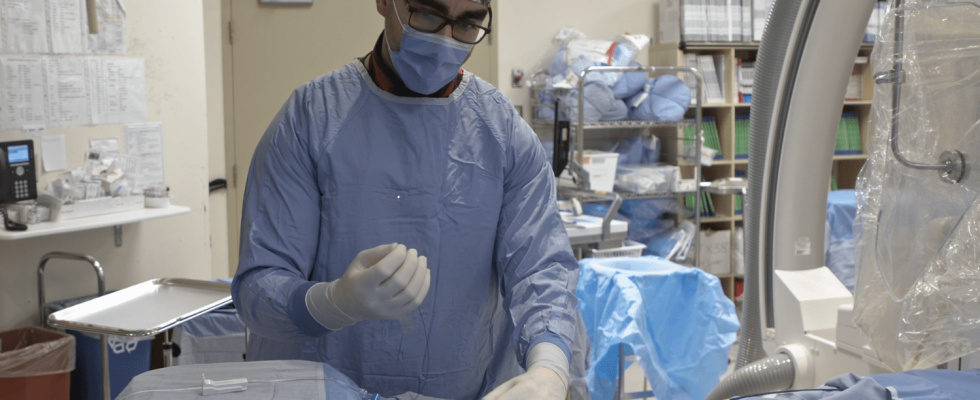Published
Reading time: 3 min

Using a camera attached to an optical fiber, a French neuroradiologist managed to film the inside of the blood vessels in the brain of a patient suffering from repeated strokes. This world first took place in November 2023 at the Ottawa Hospital, Canada.
“It’s a bit like discovering a new planet.” Robert Fahed, neuroradiologist interventionist and neurologist at the Ottawa hospitalin Canada, was able to diagnose a patient suffering from repeated strokes by inserting a camera into the blood vessels of his brain on November 14, 2023. “No one had ever seen the inside of the arteries of the brain”, underlines the doctor. A promising world first, while stroke represented the second cause of death in the world in 2019, according to the World Health Organization.
The Canadian patient, aged around fifty, suffered from a rare malformation of the carotid artery, one of the arteries that brings blood to the brain. This led to the formation of small clots which caused these strokes. This discovery was made thanks to the introduction of this camera into the patient’s blood network. “It allowed us to understand that he needed a stent [un dispositif métallique en forme de tube permettant de maintenir ouverte une artère rétrécie ou obstruée]. We were able to put the stent in, and the patient was discharged the same day. He is doing very well”, rejoices Robert Fahed to franceinfo. The intervention was carried out with the consent of the patient and the approval of Canadian health authorities.
A medical revolution in the treatment of stroke
During a demonstration, Dr. Robert Fahed, interventional neuroradiologist at the Ottawa Hospital (Canada), inserts a camera into a catheter to view the interior of the brain’s blood vessels. – (THE OTTAWA HOSPITAL FOUNDATION)
Cameras are already used in medicine to examine the inside of the lungs, colon or stomach. “These are much larger organs, much stronger and much less fragile than the brain. The brain has extremely small, tortuous and fragile arteries,” underlines Robert Fahed. The Canadian camera was designed specifically for the cerebral arteries. “It is extremely strong, and so flexible that when it hits an artery, it twists. It does not damage it,” notes the neuroradiologist. For a century, doctors had only used angiography, an invasive technique requiring the injection of a contrast product into the arteries, during X-ray imaging, in order to model the cerebral arteries.
A camera designed to guide operations
Barely thinner than a hair – its diameter measures a third of a millimeter – soft and flexible, the microangioscope uses fiber optic technology. It can navigate within the arteries of the brain of a living patient and makes it possible to “see the interior of the vessels live, either to observe what is happening there, or to observe the interactions with the tools we use, such as the use of a net to catch the clot”, explains Robert Fahed. The doctor also filmed this sequence.
Inside a cerebral blood vessel
Removal of a clot in a blood vessel in the brain, filmed by the Vena MicroAngioscope camera – (VENA MEDICAL)
The neuroradiologist plans to use this camera not only as a diagnostic tool but also as a visual guide during operations to remove clots blocking the arteries of stroke patients. Robert Fahed hopes that this new tool will help reduce stroke-related mortality. In France, Inserm counts more than 140,000 new cases of stroke each year, or one every four minutes. Two out of 10 stroke victims die in the year following their accident and four out of 10 have significant after-effects.
Beyond strokes, other uses envisaged
Robert Fahed also imagines other applications for this technology. “We will be able to observe aneurysms, hemorrhages, infections, malformations, autoimmune and auto-inflammatory diseases of the vessels”, he lists. Aneurysms alone, abnormal expansions of the wall of an artery creating a pocket of blood that can rupture, are responsible for approximately 10% of strokes. “Now, we will perhaps be able to observe directly what generates these aneurysms and optimize our ability to close them in a lasting and permanent manner”anticipates the doctor.
“In Canada, a number of patients have already started to benefit from this technology, tells franceinfo Michael Phillips, co-founder and CEO of the Canadian start-up Vena Medical, which designed the camera. “We We are working to obtain additional regulatory authorizations that would allow us to process more cases around the world, including in France.” In Paris, the Adolphe de Rothschild Foundation Hospital plans to test this new medical device in 2024.
